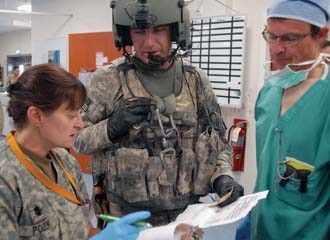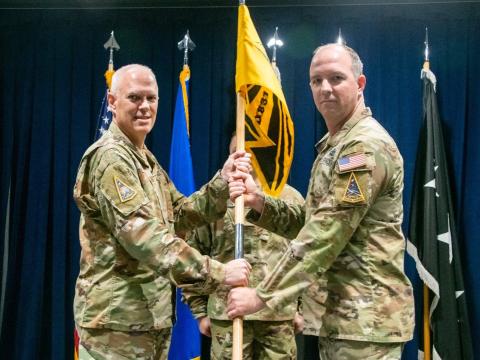Two Government Organizations, One Health Information System
 |
Sgt. Daniel Sherwin, USA (center), of Company C, 1st Battalion, 52nd Aviation Regiment, briefs members of the Kandahar Airfield NATO Role 3 Multinational Medical Unit’s trauma team on the condition of a soldier injured by a roadside bomb explosion. The U.S. Defense Department and Department of Veterans Affairs are integrating and improving the capability of their electronic health records to improve the quality of care that members of the military community receive whether in uniform or as a veteran. These records will give medical personnel the most up-to-date information about patients so they can make the best decisions for treatment. |
The U.S. Defense Department and Department of Veterans Affairs have launched an effort to combine their two electronic health record systems into one. This integrated Electronic Health Record will track medical care from the day military members join the service through the rest of their lives. The project will not be a simple joining of two legacy systems; rather, it will upgrade current tools, with personnel continually integrating new technology, capability and processes to improve functionality of the combined offering.
“We really are changing the way we do business,” Beth McGrath, deputy chief management officer for the Defense Department, says. Her office leads the integrated Electronic Health Record (iEHR) hand-in-hand with the Veterans Affairs (VA) Office of Information and Technology. The organizations have established an integrated program office with dedicated personnel from their respective staffs to direct the effort.
Work started on the new system last summer, but because of the plan to add improvements whenever possible, leaders do not identify an end date. Roger Baker, VA assistant secretary for information and technology and chief information officer, explains that, “In an ideal world, [users] will wake up one day and find out that we have snuck it in on them. All of a sudden it’s become a single electronic health record system, and they never really notice that we did it.”
Both McGrath and Baker identify the development of the iEHR as the biggest project they have going. However, McGrath says, “We’re doing it in a way that takes into account the very strong voice of the customer ... and ensuring that we’ve got a continuity of capability” in terms of both information and the ability to provide care.
Developers began by putting into place the enterprise service bus, which McGrath calls the “very foundational piece.” She identifies the bus, data standards and commonalities of process as important factors in the creation of the system. Personnel are working with clinicians to understand their priorities for the technology. “[The Defense Department and VA] collectively recognize it will take some time to transition away not only from legacy platforms, but also the ways we do business,” McGrath says. “As we define the process, the standard and the application or the capability, we’re going to roll it out as quickly as we can. It’s an integrated, incremental approach to delivering capability the fastest way we can and making sure we have the foundation in place. I would hate for people to walk away with the sense that we’re just adding on to the legacy.”
Project personnel also are learning what impacts both medical providers—including pharmacists—and patients in an effort to better understand what they need. With that knowledge, project staff can define the capabilities to build into the iEHR. Baker states, “I’d also point out that getting the governance right has been pretty critical. Both of our medical organizations are deeply involved in doing this. It’s not just an information technology project—it’s a medical project.”
The VA and Defense Department have agreed to use common data standards, a common data representation and common data stores based on an open version of the data standards already implemented on the military side. “Above that is where the common services broker fits in, which is an implementation of a standard set of interfaces for how you access data, how you do identity and a variety of other things that are going to be critical to every application,” Baker explains. Developers have identified approximately 127 different medical applications they want to integrate on top of the broker from the standpoint of a suite of systems. “And then on top of that we will have a common graphical user interface in all of those applications,” Baker adds. “So from a technical standpoint, really those four levels kind of lay out the basic architecture.” Activity already is moving on all of the levels, including on the service-oriented architecture that will be part of the system.
McGrath explains that the military data standard adopted for the iEHR system is one of only a few business areas that are common across the defense enterprise. She describes it as an enormous undertaking, dealing with a large population that is highly mobile. “It is critical that they have their most current information wherever they are, whether they are deployed or whether they move to a new duty station,” she says. That concept now will extend to include the veteran population so that active duty, Guard or Reserve troops, veterans or family members can access their information anywhere in a form usable to health care providers.
Having all information available in native data formats will benefit patients as they transition from military service to veteran status. Currently, the organizations’ systems have to translate data passed between them. Baker explains that eliminating the translation will make information available more readily. Switching to VA care will resemble moving from one military hospital to another instead of moving into a different government agency. “That will really improve quality of care and our ability to provide services for those service members as they transition to the VA,” he says. It also will make benefit claims easier to process because VA personnel can access health care documented during military service.
The iEHR fits into the larger virtual lifetime electronic record, a business and technology initiative introduced by the president that includes a portfolio of health, benefits, personnel and administrative information sharing among government and private organizations. “On the medical side, this is an important component of the virtual lifetime electronic record,” Baker says.
Both Baker and McGrath say that the iEHR will provide members of the military community with a benefit they deserve. McGrath explains, “I have a lot of responsibility in the business space over here, but it’s very easy to really put purpose behind this because you’re talking about having the accurate information with which to make decisions on a real-time basis. It’s not a simple accounting transaction. It’s whether or not an individual has a life-threatening allergy or something like that. It’s so critically important not only to the individual but also for readiness.” She adds that having a more detailed medical knowledge of personnel will help to enable the national security mission.
To facilitate the process of electronic health records, the military conducts conversations about them with troops as they enter service. McGrath says the department focuses on capturing information properly and explaining to individuals that the information will feed the rest of their careers, whether it be for medical decisions or future rotational assignments. An important part of ensuring appropriate care is identity management. The VA and the military use the Defense Manpower Data Center as the common mechanism to ensure proper identification of system users.
As the iEHR moves forward, the stakeholders plan to incorporate the technology available from industry. Baker explains that 20 years ago, the government was a leader in this type of information system. Over time, that paradigm shifted as companies have invested more in relevant products and components. “We view the open source as a key piece of how we embrace the private sector here,” he says. “It is important to the way that we go about developing the iEHR, and it’s kind of an important symbol that there will be real private-sector involvement in what we’re doing.”
McGrath adds that iEHR personnel are looking for the best way to implement industry capabilities based on common business practices and standards as quickly as possible. “We’ll fully embrace the ideas that come through the open-source venue as well as look for more mature capabilities and technology that exist that can plug into this common platform,” she says.
The role of the private sector in the iEHR will include traditional contracts to help build the system as well as the integration of their technologies into the system. For example, as the pharmacy capabilities of the organizations’ currently separate electronic records are upgraded in the new integrated system, developers—at the direction of the secretaries of the VA and Defense Department—will look to buy an existing package from industry.
One of the largest concerns with the iEHR is the confidentiality of patient information. Baker says, “There is a substantial focus on privacy both at the Defense Department and VA. So I understand the thought and the potential concern, but the benefit of having that information at the point of service is pretty high.”
McGrath personalizes the issue, explaining that she would want any doctors she visits to have all the information they need to make the best decisions for next steps. “Right now, the doctor is relying on less information rather than more,” she explains. With access to the iEHR, health care providers will have more data so they can make the best possible decisions with regard to treatment options, McGrath adds.
To help ensure an effective, robust solution, the VA and Defense Department are piloting programs whenever feasible. One such effort is the Captain James A. Lovell Federal Health Care Center in North Chicago. This first-of-its-kind partnership between the VA and the military incorporates all medical care into one federal health care facility with a single combined VA and Navy mission. “Our two organizations actually occupy a single building and work side by side in an integrated fashion to take care of their patients,” McGrath says.
Though the facility does not include an integrated electronic record system, McGrath states that both VA and defense practitioners can see more information than in traditional health centers. “Our intention is to use a North Chicago wherever we possibly can not only to talk about how should we do this, but also to test it out,” she explains. “Their numbers are incredible ... It’s important that folks know we’re not waiting four to 10 years to do this.”
WEB RESOURCES
Defense Deputy Chief Management Officer: http://dcmo.defense.gov
Veterans Affairs Office of Information and Technology: www.oit.va.gov
Lovell Federal Health Care Center: www.lovell.fhcc.va.gov
Virtual Lifetime Electronic Record: www.prim.osd.mil/init/vler.html




Comments